
Cesare Borgia was a Spanish-Italian cardinal and condottiero, an illegitimate son of Pope Alexander VI and member of the Valencian (Spanish-Aragonese) House of Borgia. His fight for power was a major inspiration for The Prince by Niccolò Machiavelli.
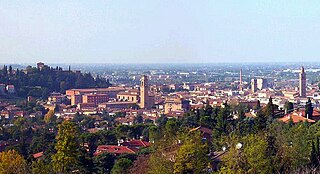
Cesena is a city and comune (municipality) in the Emilia-Romagna region of Italy; and - with Forlì - is the capital of the Province of Forlì-Cesena. Served by Autostrada A14, and located near the Apennine Mountains, about 15 kilometres from the Adriatic Sea. The total population is 97,137.

The House of Borgia was a Spanish noble family, which rose to prominence during the Italian Renaissance. They were from Xàtiva, Kingdom of Valencia, the surname being a toponymic from the town of Borja, then in the Crown of Aragon, in Spain.

Forlimpopoli is a town and comune in the province of Forlì-Cesena, north-eastern Italy. It is located on the Via Emilia between Cesena and Forlì.

Cento is a town and comune in the province of Ferrara, Emilia-Romagna, Italy.
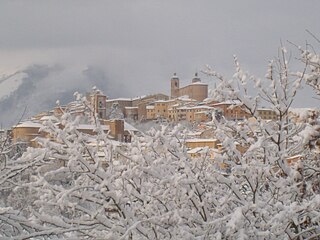
Camerino is a town in the province of Macerata, Marche, central-eastern Italy. It is located in the Apennines bordering Umbria, between the valleys of the rivers Potenza and Chienti, about 64 kilometres (40 mi) from Ancona.
Duke of Camerino is a title of nobility, originally in Papal peerage. It was created on 1503 by Apostolic authority of Pope Alexander VI and cardinal council over the ancient Marquissate of Camerino, which was part of the Dukedom of Spoleto.

Meldola is a town and comune near Forlì, in Emilia-Romagna, Italy.
Giovanni Borgia, known as the Infans Romanus, was born into the House of Borgia in secret and is of unclear parentage. Speculations of the child's parentage involve either Lucrezia Borgia with her alleged lover, Perotto Calderon or Cesare Borgia, or Pope Alexander VI as his father. Cesare Borgia's biographer Rafael Sabatini says that the truth is fairly clear: Alexander fathered the child with an unknown Roman woman.

Rocca Priora is a small town and comune in the Metropolitan City of Rome, Lazio, Italy. It is one of the Castelli Romani on the Alban Hills about 25 kilometres (16 mi) southeast of Rome, situated in the Regional Park known as the "Parco Regionale dei Castelli Romani".

Sigillo is a comune (municipality) in the province of Perugia in the Italian region Umbria, located about 35 km northeast of Perugia.

Sacrofano is a comune (municipality) in the Metropolitan City of Rome in the Italian region of Latium, located about 25 kilometres (16 mi) north of Rome. Located near the Monti Sabatini, at the feet of an extinct volcano, it is included in the Regional Park of Veii.
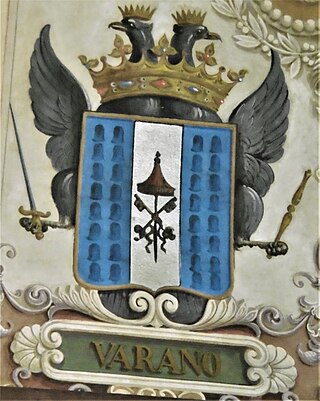
The Da Varano was an Italian noble family who had an important role in the medieval and Renaissance history of central Italy, as rulers of Camerino and other lands in the Marche and Umbria.
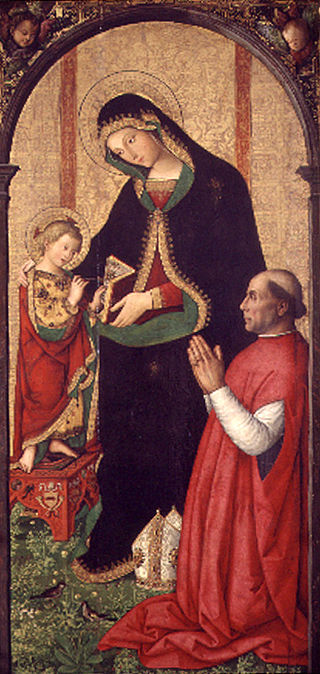
Francisco de Borja y Navarro de Alpicat was a Spanish cardinal, and the seventh of ten cardinal-nephews created by Pope Alexander VI.

Oliverotto Euffreducci, known as Oliverotto of Fermo, was an Italian condottiero and lord of Fermo during the pontificate of Alexander VI. His career is described in Niccolò Machiavelli's Il Principe.
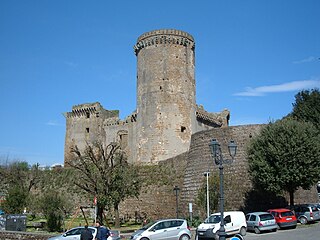
The Castello Borgia is a 16th-century castle in Nepi, in province of Viterbo, Italy originally refurbished for Lucrezia Borgia. The castle features a large square piazza surrounded by walls on all sides and circular towers at each corner.

The Rocca Abbaziale is an abbey, designed as a castle, in Subiaco, Lazio, Italy.
A number of Italian castles are associated with the Borgia family of Pope Alexander VI including:
Duke of Romagna is a title of nobility, originally in the papal peerage. It was created in 1501 by the Apostolic authority of Pope Alexander VI and the cardinal council for Cesare Borgia, Duke of Valentinois, after his conquest of Romagna, Urbino, and Camerino.















